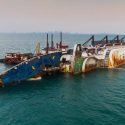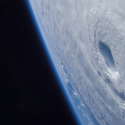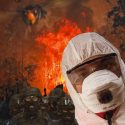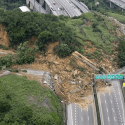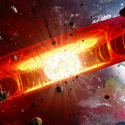You’re fishing in a lake, on a nice sunny day. When suddenly, you begin to smell rotten eggs. And before you know it, the lake explodes.
Your boat starts rocking violently, and you begin to feel dizzy. In the distance, you see a 20 m (65 ft) high wave coming towards you. Now you’d better get out of there before it’s too late.
A limnic eruption is an incredibly rare and dangerous natural disaster. It happens when a lake sits near a pool of magma. Since the magma gives off carbon dioxide, it builds up underground over time.
Eventually, the CO2 bursts, creating a massive explosion in the lake. When this happens, carbon dioxide gasses spread everywhere, and tsunami-like waves pop up out of nowhere.
Luckily, this has only happened a couple of times. But when it does, the results are devastating.
In Cameroon, a limnic eruption occurred in 1986, killing over 2,000 people and wiping out entire communities. If you were near a lake during a limnic eruption, how would you
survive?
How much damage can a limnic eruption cause? How can your nose be your best chance for survival? And why can breathing be dangerous?
Step 1: Smell
Before the lake erupts, pay attention to your nose. If you smell rotten eggs, that means an eruption could happen soon. Also, check to see if the water is warmer than usual. That’s another sign of an imminent eruption.
As this is happening, move away from the lake as quickly as possible. This will help you to survive the initial blast.
Step 2: Don’t Breathe
When the limnic eruption occurs, hold your breath immediately. The magma chambers underneath this lake are erupting millions of cubic meters of carbon dioxide. Carbon dioxide can be fine at low concentrations, but high concentrations greater than 10% will occur from the eruption. If you start breathing it in, you’ll quickly pass out, and die. So hold
your breath for as long as you can.
Step 3: Drive away
Now that you’ve survived the initial blast, it’s time to get out of there. Don’t run away on foot. Instead, get in a car and drive away.
You’ll want to move fast, as both the water and carbon dioxide will cover some serious ground. Anyone in a 25 km (15 mi) radius of the eruption will either get hit by the tsunami-like wave, or suffocate from the carbon dioxide.
Step 4: Get to higher ground
When you begin to drive, immediately move towards higher ground. This is the quickest and safest way to avoid the aftermath of the eruption. Since carbon dioxide is denser than air, it will sink to the ground, and breathable air will be pushed upwards. Not to mention, reaching higher ground will also help you avoid the rushing waters.
Step 5: Call for Help
You’re on higher ground, but now, you’re trapped. Below you are carbon dioxide and rushing waters from the tsunami. You’ll need to call for help, and might be rescued by a boat or a helicopter, depending on how severe the eruption is.
Now, you can finally leave these treacherous conditions. Phew. That was a close one. But probably not as close as surviving a pyroclastic flow, right?
Subscribe to What-If on YouTube or follow the show on Facebook Watch.
Sources
- “What Makes A ‘Killer’ Lake Explode?”. Howstuffworks.
- “Exploding Lakes – Scientific Scribbles”. 2012. blogs.unimelb.edu.au.
- “Carbon Dioxide Poisoning”. Langford, Nigel J. 2005. Toxicological Reviews 24 (4): 229-235. doi:10.2165/00139709-200524040-00003.
- “Is Carbon Dioxide Poisonous?”. 2020. Thoughtco.
- “Pilot plant for the removal of extreme gas charges from deep waters installed”. 1418. Eurekalert!.
- “Gas Cloud Kills Cameroon Villagers”. 2020. HISTORY.
- “Defusing Africa’s Killer Lakes”. Krajick, Kevin. 2003. Smithsonian Magazine.


